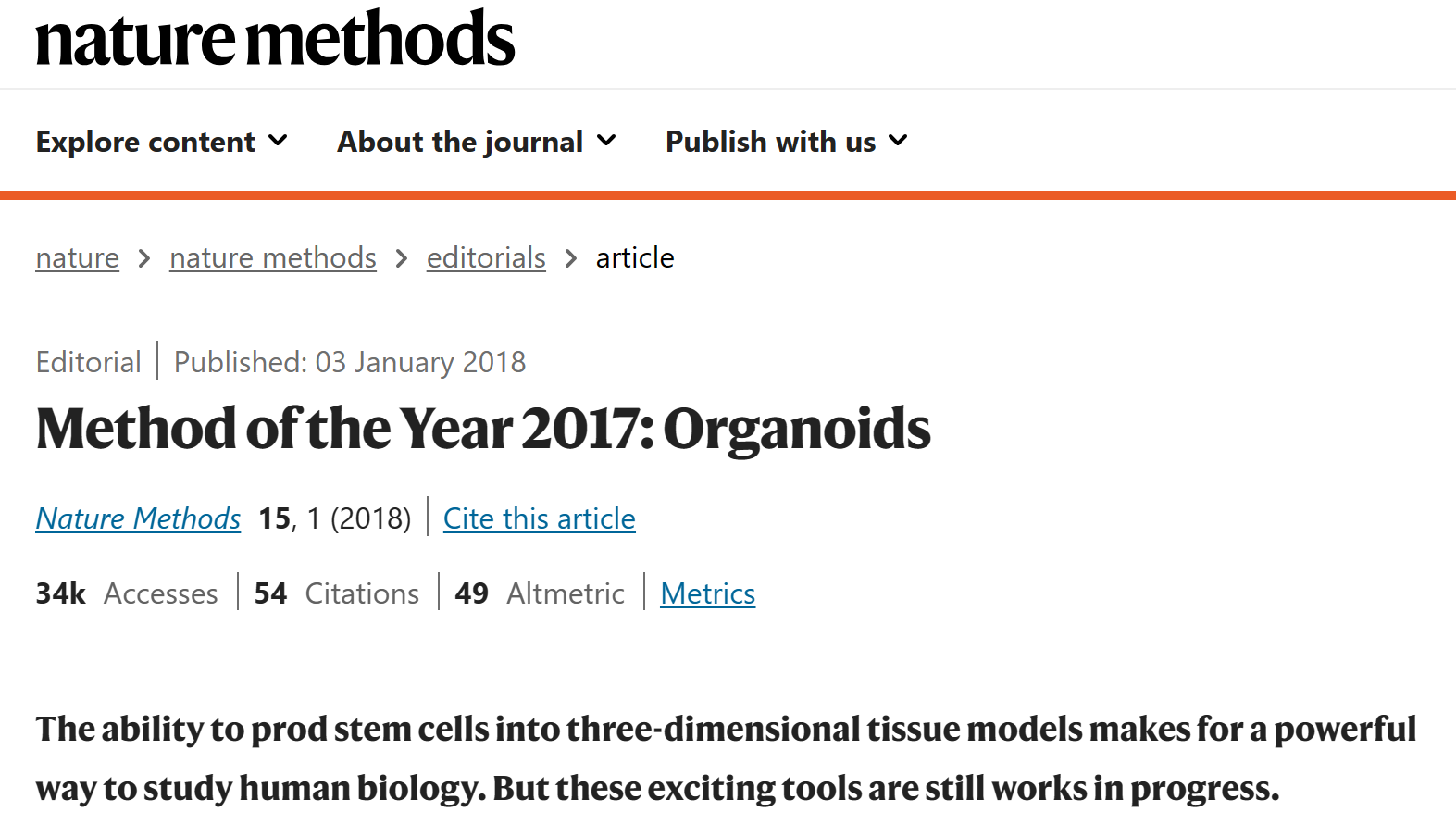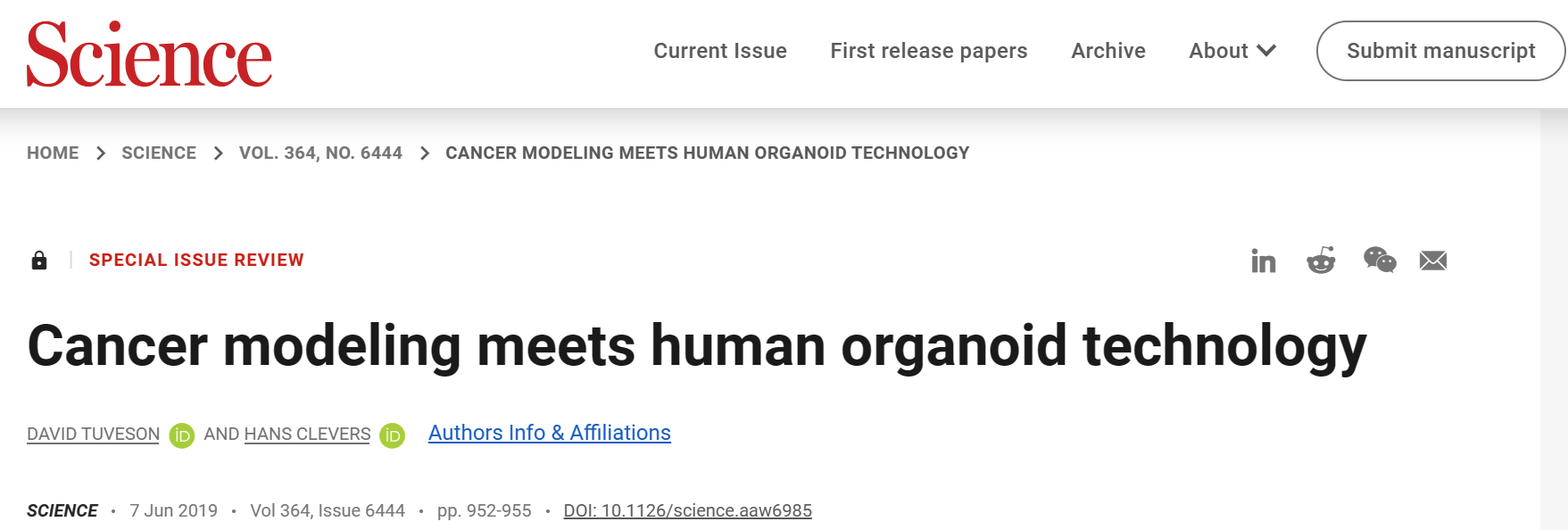In 2009, the team led by Hans Clevers from the Netherlands achieved a significant breakthrough in the field of three-dimensional (3D) organ culture in vitro, successfully cultivating mouse gut organoids with self-renewal capabilities that maintained the intestinal crypt-villus structure in vitro [1]. Since then, organoid technology has emerged onto the stage of human scientific research and development.

Organoids, as the name suggests, are organ-like models that are microscopic three-dimensional structures formed by stem cells, including pluripotent stem cells (PSC) and adult stem cells (ASC), during in vitro culture, capable of self-assembly. Due to their similar spatial organization to the corresponding organs, retention of some key characteristics, and ability to recapitulate partial physiological functions, they are considered as new models for studying human biology and diseases. Compared to traditional research models such as cell lines, genetically engineered mouse models (GEMMs), and patient-derived xenografts (PDX), organoid models (including mouse-derived organoids, MDO, and patient-derived organoids, PDO) not only can be derived from normal tissues and tumor tissues at various stages of carcinogenesis, but also have a simple and easy-to-operate culture system with lower time and monetary costs, and higher efficiency. Therefore, they have gained the favor of many researchers and were named the annual technology in the field of life sciences by Nature Methods in 2017.

On June 7, 2019, David Tuveson from Cold Spring Harbor Laboratory in the United States and Hans Clevers from the Hubrecht Institute in the Netherlands co-authored an article titled "Cancer Modeling Meets Human Organoid Technology" in Science, summarizing how organoid technology can be applied to cancer research.

I. Establishing Tumor Organoid Biobanks
Currently, most samples used by cancer alliance organizations such as the International Cancer Genome Consortium (ICGC) and The Cancer Genome Atlas (TCGA) are derived from primary tumors. In contrast, patient-derived organoids (PDOs) can be obtained from any stage of tumor development, and only a small amount of tumor tissue is required for in vitro culture and expansion. Researchers have successfully cultured organoids in vitro from biopsy samples obtained through puncture in liver cancer [2], pancreatic cancer [3], and colorectal cancer liver metastasis [4] tissues. Gao et al. were even able to culture circulating tumor cells from prostate cancer patients into organoids in vitro [5]. Researchers have also successfully cultured organoids from normal cells in urine [6] and bronchial lavage [7], but it is unclear whether these culturing methods can be applied to the culturing of tumor organoids derived from these tissues.
PDOs cultured in vitro can well reflect the characteristics of most bulk tumor tissues [4]. For example, PDOs extracted and cultured from colorectal cancer (CRC) tissues and adjacent normal tissues, through molecular mechanism and functional analysis, can reveal that CRC cells have a large number and diversity of mutations compared to normal cells [8]. Although the DNA methylation diversity and transcriptome status within each tumor are stable, even within the same tumor, the response to anticancer drugs varies, indicating that epigenetic changes greatly influence cell gene expression, leading to tumor heterogeneity and presenting different drug responses. This is a major challenge currently faced by organoid technology, namely how to better track and analyze intra-tumor heterogeneity. In addition, another challenge is how to ensure that organoids do not undergo clonal drift during long-term culture, although studies have shown that the probability of this occurring is small [9].
Therefore, for organoids derived from various mutated cells (or lineages) and different organ tissues, in order to optimize their long-term culture conditions and better understand and study the process of tumorigenesis through organoids, it is necessary to establish organoid biobanks. Currently, the non-profit organoid technology organization HUB in the Netherlands (www.hub4organoids.eu) has established an organoid biobank, similar to ATCC (American Type Culture Collection), with over 800 different organoid types with known genetic information and other characteristics for selection and use by research institutions, universities, and companies. At the same time, The Human Cancer Models Initiative (HCMI) is continuously establishing different tumor culture models and developing them into shared resources.
Organoid Technology Can Simulate Tissue Carcinogenesis In Vitro
In studying the process of tissue carcinogenesis, tumor organoids can be obtained not only from tumor tissues at different stages of development but also through genetic editing of normal organoids, which allows for the isolated study of the function of a specific gene or combination of genes.
Taking CRC (colorectal cancer) as an example, according to the adenoma-carcinoma sequence theory, the development of CRC is the result of a series of genes undergoing mutations in a specific order. J. Drost et al. used CRISPR/Cas9 technology to sequentially mutate APC, P53/TP53, KRAS, and SMAD4 in intestinal organoids and found that the mutated organoids could grow and proliferate independently of any exogenous cytokines. When these organoids, carrying all four mutations, were transplanted back into mice, they induced the development of invasive CRC [10]. A. Fumagalli et al. further confirmed that metastasis could only occur when all four mutations were present simultaneously [11]. Similarly, researchers mutated APC in normal Barrett's esophagus organoids to induce cellular carcinogenesis [12]; they also mutated Braf, Tgfbr2, Rnf43/Znrf3, and P16/Ink4A simultaneously in normal colorectal organoids to obtain serrated adenocarcinomas [13]; and they sequentially mutated KRAS, CDKN2A, TP53, and/or SMAD4 in normal pancreatic organoids to generate pancreatic ductal adenocarcinomas [14]. In addition, edited organoids can be subcloned for better study of gene function. For example, knocking out key DNA repair genes and subcloning the mutated organoids for culture revealed the emergence of new mutational signatures [15]. Thanks to recent advances in stem cell gene knock-in technology, organoids have become visualizable. Sato T et al. traced the lineage of the stem cell marker LGR5 and found that LGR5+ cells exhibit cancer stem cell properties during tumorigenesis, with self-renewal and differentiation capabilities [16]. Researchers further discovered that when LGR5+ tumor cells were knocked out, there was a transient regression of the tumor. Subsequently, differentiated tumor cells marked by KRT20 could reprogram into LGR5+ self-renewing cancer stem cells, thereby continuing to promote tumor growth. This indicated that CRC tumor growth depends on LGR5+ cancer stem cells, and differentiated tumor cells can also dedifferentiate into stem cells to replenish the cell pool within the cancer stem cell niche [16]. Currently, organoid technology based on ASCs (adult stem cells) cannot be used to culture normal central nervous system (CNS) tissues. However, PSC (pluripotent stem cells)-derived organoids can effectively mimic the development and progression of brain tumors [17].
II. Organoid Coculture Technology Enhances Characterization of the Tumor Microenvironment and Immunotherapy
The tumor microenvironment (TME) is the habitat for tumor cells and constantly influences their development. However, current research tools are unable to fully characterize this microenvironment. Although tumor organoid culture systems do not encompass the entire TME, some studies have found that coculturing specific cell types within the TME with tumor organoids can partially characterize the TME. Coculturing pancreatic stellate cells with pancreatic ductal adenocarcinoma organoids (PDOs) revealed that these stellate stromal cells began to transform into fibrotic stromal cells specific to pancreatic tumors, with some even differentiating into cancer-associated fibroblasts (CAFs), which promote organoid proliferation by secreting IL-6 [18]. Coculturing PDOs with CAFs showed that PDOs can induce the generation of different CAF subtypes, providing a basis for regulating CAF composition within tumors [19]. Apart from stromal cells, another important component of the microenvironment is immune cells. Currently, exploration of coculture technology with immune cells is still in its relatively early stages. The Kuo team from the United States has been attempting to use air-liquid interface (ALI) organoid culture technology since 2009 to replicate primary tumor tissue and its microenvironment. In 2018, they used this method to integrate PDOs with immune cells or fibroblasts for coculture, maintaining the diversity of patient T-cell clones for several weeks. They also successfully applied this technology to evaluate the efficacy of immunotherapy targeting immune checkpoints [21]. Additionally, coculturing PDOs from patients with high mutational burden or tobacco-related non-small cell lung cancer with their corresponding peripheral blood revealed that these PDOs could effectively present antigens to T cells, thereby activating and proliferating CD8+ T cells [21]. In principle, this method can generate a large number of effector T cells in vitro for adoptive T-cell therapy in patients.
III. Organoid Technology is Emerging as a Tool for Personalized Medicine
Personalized medicine using organoid technology refers to developing treatment drugs and methods suitable for an individual through drug screening and genotype analysis of organoids in vitro. To date, PDOs of different tumors have shown varied responses to traditional and investigational drugs. Limited research resources have found that the therapeutic responses exhibited by most PDOs are consistent with the initial treatment responses of their corresponding patients [22-26]. PDOs can also be used to develop new drugs targeting passive or acquired resistance [23]. More importantly, PDOs are highly sensitive to cytotoxic drugs, thus better predicting clinical responses in patients after use [24-26]. Next, researchers integrated and analyzed drug response data from a large number of individual PDOs to identify common features, thereby conducting biomarker development research for a similar group of patients [24].
There is a concurrent desire to apply organoid technology as a "personalized cancer test" akin to a "bacterial test," and this idea has been put on the agenda by the Blue Ribbon Panel for the Cancer Moonshot in the United States. Current clinical experimental studies can apply results derived from limited individuals (i.e., empiric PDO responses) to a large number of patients of the same type. Similarly, newly developed chemotherapy drugs can also be tested using the same method. If empiric tests of PDOs show good results in a large sample, then appropriately designed clinical trials can be expanded.
IV. Opportunities and Challenges Coexist
The current organoid technology also faces numerous challenges. In terms of the organoids themselves, tumor models of different organs are not easily distinguishable and may not be representative; the culturing period is relatively long; the cost is not yet affordable for everyone; and high-throughput drug screening and immunotherapy screening methods are not yet perfect. In terms of the microenvironment, besides coculturing with immune cells or fibroblasts, there is also the challenge of incorporating blood vessels and nerve cells into the culturing system for multidimensional culturing. However, the authors always believe that organoid technology will greatly promote research in both basic science and clinical treatment, becoming a valuable tool for them.
In tribute and memory of Yoshiki Sasai, who made outstanding contributions to modern organoid research
Yoshiki Sasai (1962 - August 5, 2014) was a developmental biologist, stem cell, and organoid scientist. The biological community praises him as "someone who could see what others couldn't," "whose success was built on hard work," "a person who was strict with himself but lenient with others," and "whose work inspired others."
References
[1] T. Sato et al., Nature 459, 262–265 (2:009).
[2] S. Nuciforo et al., Cell Rep. 24, 1363–1376 (2018).
[3] H. Tiriac et al., Gastrointest. Endosc. 87, 1474–1480 (2018).
[4] F. Weeber et al., Proc. Natl. Acad. Sci. U.S.A. 112, 13308–13311 (2015).
[5] D. Gao et al., Cell 159, 176–187 (2014).
[6] F. Schutgens et al., Nat. Biotechnol. 37, 303–313 (2019).
[7] N. Sachs et al., EMBO J. 38, e100300 (2019).
[8] S. F. Roerink et al., Nature 556, 457–462 (2018).
[9] M. Fujii et al., Cell Stem Cell 18, 827–838 (2016).
[10] J. Drost et al., Nature 521, 43–47 (2015).
[11] A. Fumagalli et al., Proc. Natl. Acad. Sci. U.S.A. 114, E2357–E2364 (2017).
[12] X. Liu et al., Cancer Lett. 436, 109–118 (2018).
[13] T. R. M. Lannagan et al., Gut 68, 684–692 (2019).
[14] T. Seino et al., Cell Stem Cell 22, 454–467.e6 (2018).
[15] J. Drost et al., Science 358, 234–238 (2017).
[16] M. Shimokawa et al., Nature 545, 187–192 (2017).
[17] S. Bian et al., Nat. Methods 15, 631–639 (2018).
[18] D. Öhlund et al., J. Exp. Med. 214, 579–596 (2017).
[19] G. Biffi et al., Cancer Discov. 9, 282–301 (2019).
[20] J. T. Neal et al., Cell 175, 1972–1988.e16 (2018).
[21] K. K. Dijkstra et al., Cell 174, 1586–1598.e12 (2018).
[22] S. H. Lee et al., Cell 173, 515–528.e17 (2018).
[23] S. J. Hill et al., Cancer Discov. 8, 1404–1421 (2018).
[24] H. Tiriac et al., Cancer Discov. 8, 1112–1129 (2018).
[25] G. Vlachogiannis et al., Science 359, 920–926 (2018).
[26] C. Pauli et al., Cancer Discov. 7, 462–477 (2017).






